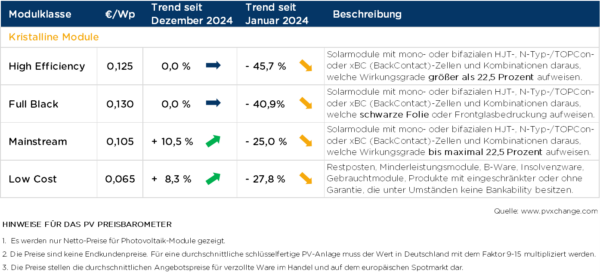First, the good news: Early this year, module prices have remained stable across high-efficiency products and other typologies. Even modules with a fully black appearance, reintroduced in the price index in January, are seeing minimal price movement.
The upward trends in lower price categories reflected in the graph and barometer below stem partially from updated typology divisions. Advances in technology have shifted the boundary between high-efficiency and mainstream modules to 22.5%.
Now, the bad news: As predicted in December 2024, product availability is worsening, especially for high-performance PV modules. These modules, often reserved for large-scale projects or select customers, remain scarce.
Free inventory usually arises only when projects are delayed or canceled. Short-term access to certain inverters and storage systems is also problematic, forcing suppliers to suggest alternatives. Logistics challenges post-holiday season and delayed production restarts from some manufacturers exacerbate the situation. Notably, Chinese manufacturers, aiming to counteract destructive competition and overproduction within Europe, have created artificial shortages.
The end-of-year price crash in 2024 added to the complexity. In November and December, suppliers offloaded warehouse stock at rock-bottom prices to clean up balance sheets, leaving the market saturated with low-cost inventory. With the first quarter typically quiet, demand for new goods remains weak, particularly in Germany. Here, uncertainty around potential government changes and the global implications of Donald Trump’s reelection have stalled momentum.
The trajectory of module prices – whether rising, stagnant, or falling – depends largely on national and international demand in the coming months. Almost any scenario is possible, with no clear certainty.
Changes to the module price index further complicate the picture. Modules with outputs like 440 W and 575 W, considered rare and expensive six months ago, have now become standard products. The efficiency threshold for high-efficiency modules now begins at 22.5% or specific outputs such as 450 W, 585 W, and 700 W, depending on format. Manufacturers’ data sheets, however, often exclude the frame area when reporting efficiency, leading to discrepancies. Suppliers typically charge more for higher-performance classes, even when production technology remains the same.
This reclassification has altered pricing. For instance, the January price point for mainstream modules includes several performance classes previously classified as high-efficiency. The mainstream index now reflects fewer inexpensive modules, creating uncertainty visible in the accompanying chart’s hatching. Using prior calculation methods, the mainstream price increase appears less dramatic, while high-efficiency prices have moderately declined rather than stagnated.
Full black modules, reintroduced in the price index after a hiatus since April 2022, demonstrate a slight price premium. Historically, these modules commanded no price difference compared to black-and-white products. However, customer demand for aesthetics in residential installations has driven a price difference of several euro cents per watt-peak. For glass-glass modules, primarily bifacially manufactured, these premiums arise from the appearance achieved by back glass printing rather than production costs.
Customers’ willingness to pay more for black modules may reflect meticulous cell sorting required for uniform appearance, though quality concerns persist. The longevity of this premium remains unclear, but market observers continue monitoring price developments and engaging manufacturers to address product quality concerns.

(1 Euro equal to $1.04 U.S. Dollars)
About the author: Martin Schachinger has studied electrical engineering and has been active in the field of photovoltaics and renewable energy for almost 30 years. In 2004, he set up the pvXchange.com online trading platform. The company stocks standard components for new installations and solar modules and inverters that are no longer being produced.
The views and opinions expressed in this article are the author’s own, and do not necessarily reflect those held by pv magazine.
This content is protected by copyright and may not be reused. If you want to cooperate with us and would like to reuse some of our content, please contact: editors@pv-magazine.com.








By submitting this form you agree to pv magazine using your data for the purposes of publishing your comment.
Your personal data will only be disclosed or otherwise transmitted to third parties for the purposes of spam filtering or if this is necessary for technical maintenance of the website. Any other transfer to third parties will not take place unless this is justified on the basis of applicable data protection regulations or if pv magazine is legally obliged to do so.
You may revoke this consent at any time with effect for the future, in which case your personal data will be deleted immediately. Otherwise, your data will be deleted if pv magazine has processed your request or the purpose of data storage is fulfilled.
Further information on data privacy can be found in our Data Protection Policy.